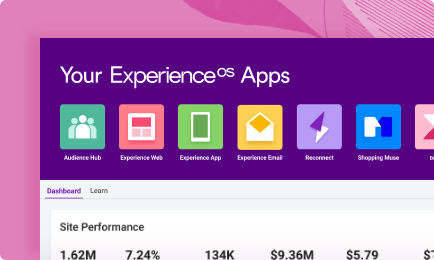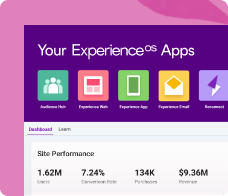The Perfect Match: Marry Your CMS and Personalization Systems for Customer Love
How creating an interconnected composable marketing ecosystem helps you deliver an experience your customers will fall in love with.
In today’s rapidly changing digital landscape, finding out two technologies are perfectly compatible is the equivalent of love at first sight. And using that compatibility to create meaningful, individualized customer connections in an era of unparalleled standards? A romance for the ages.
You can achieve this timeless love for your brand by marrying your CMS with a personalization engine. Integrating these systems unlocks magic that overcomes the hurdles of managing and delivering personalized content across platforms, like inconsistent messaging, content silos, AI limitations, and rigid, monolithic architectures. Ultimately, integrating your CMS and your personalization system allows you to deliver hyper-relevant content at scale and creates a swoon-worthy experience for your customers.
The Systems Defined:
Content Management Systems (CMS) provide the infrastructure for a seamless content workflow, from ideation to publication, ensuring that all assets are centralized, up-to-date, and accessible across different platforms and channels. Imagine your CMS as your organization’s single source of truth when it comes to content.
Personalization Engines, on the other hand, sit atop systems (like a CMS) to analyze user data, behavior, and preferences and deliver content that makes each interaction feel bespoke. Personalization engines help users see your channels not as static entities, but as dynamic ecosystems that adapt to each visitor’s unique needs and preferences, increasing engagement, loyalty, and conversion rates in the process.
The Perfect Match:
Personalization engines offer robust capabilities for personalizing content elements across web, app screens, and emails, as they can automatically synchronize data, image assets, and content directly from the CMS. These engines are typically agnostic, meaning they can integrate with any CMS—whether traditional or headless—through various methods such as data feeds, webhooks, API calls, and more.
By marrying your CMS and personalization engine, you can start producing variation feeds. These variation feeds can be automatically synchronized between systems, activating targeting conditions based on specified criteria. Over time, these variations render and continuously optimize using sophisticated algorithms like multi-armed bandits. It won’t be long until these algorithms produce the most optimal content variation, ensuring each user experience is as engaging and relevant as possible.
Cross-channel Consistency
Cohesive cross-channel messaging is key to iron-clad brand unification. But too often, with a disjointed tech stack, marketing professionals are forced to input and maintain content across multiple systems, resulting in mismatched brand messaging and leading to negative customer experiences. Say, for instance, a shopper gets served a personalized banner promoting sneakers and clicks through to purchase them, but is then informed that the sneakers are out of stock. That shopper is likely frustrated and could even take their business elsewhere. But marketers can redo that same scenario with interconnected systems by going into the CMS and replacing the out-of-stock item banner, automatically updating the personalization engine and ensuring the shopper only gets recommendations for available sneakers.
Content Assembly and Delivery
Keeping content organized while also hyper-personalized sounds like it could be a real lover’s quarrel. However, marrying the two systems does just the opposite. It keeps assets like live streams, product recommendations, and social media feeds, that may be housed in multiple places, accessible and categorized. If an asset is tagged by customer affinity, for example, a personalization layer can dynamically assemble these from multiple sources for any given campaign and provide recommendations in-real time, improving the relevance and timeliness of the assets and leading to deeper user connection. In terms of delivery, a personalization engine can optimize that too, algorithmically directing traffic to the best-performing content variant.
The open nature of personalization solutions (such as Dynamic Yield’s Experience OS) allows for seamless integration with third-party content platforms, including Digital Asset Management systems (DAMs), Web Content Management systems (WCMs), and content repositories. This means you can input digital, visual, and multimedia assets once and reuse it across applications and channels, keeping your messaging standardized and centralized.
The AI Advantage
Artificial Intelligence (AI) has critically advanced personalization efforts, and organizations can use it to elevate their content delivery strategy, beyond just speeding up processes and increasing productivity. Premium personalization solutions leverage adaptive AI and artificial neural networks (ANN) to handle complex datasets, automatically expanding product catalogs and sharing insights across applications and channels using centralized, self-learning algorithms. Generative AI, too, can auto-generate copy for emails, web, and app personalization campaigns, pushing the boundaries of content personalization.
The Composable Culture Shift
Integrating a CMS and personalization system creates a more agile, streamlined process flow and investing in composable technologies takes that velocity to the next level. Composable technology is a modular architecture where components can easily be added, altered, or replaced. Going the composable route provides an unparalleled amount of flexibility, enabling organizations to adapt quickly to the evolving digital landscape. Composable technology is the backbone of the growing MACH architecture (Microservice, API-first, Cloud-native, and Headless) movement.
“In the evolving landscape of digital transformation, the future belongs to composable technology,” says Jasmin Guthmann, Executive Board Member of the MACH Alliance and Head of Corporate Communications at Contentstack, a Dynamic Yield partner. “By embracing modularity and flexibility, organizations unlock the power to rapidly innovate, scale, and customize their digital ecosystems. As the demand for agility and efficiency grows, the composable approach offers an edge to stay ahead in an ever-changing market, empowering businesses to adapt, thrive, and lead in the digital era.”
A Happily Ever After Between Systems
Ready to fall in love? Request a demo to learn more about the CMS’s Dynamic Yield integrates with, like Contentstack, and we’ll dive into how it can streamline and benefit your organization.















